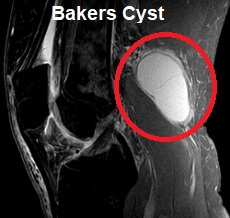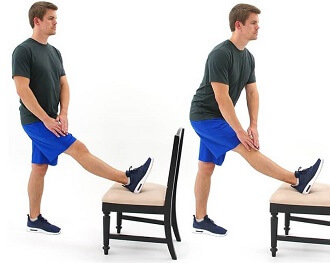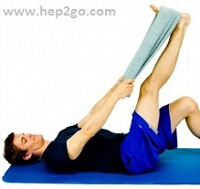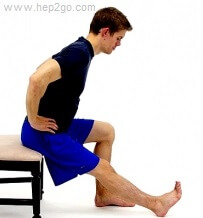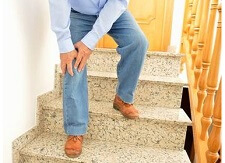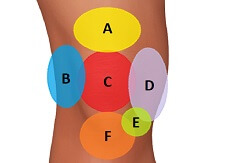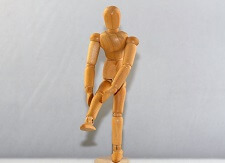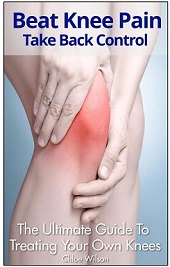- Home
- Common Knee Conditions
- Bursitis
- Bakers Cyst
- Exercises
Bakers Cyst Knee Treatment
Written By: Chloe Wilson, BSc(Hons) Physiotherapy
Reviewed by: KPE Medical Review Board
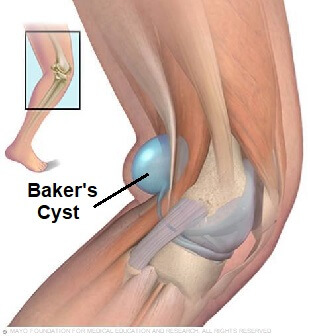
A Bakers Cyst knee aka popliteal cyst develops when there is inflammation of the popliteal bursa – a small fluid filled sac at the back of the knee that acts as a cushion between the hamstring muscles and the knee bones.
It causes swelling at the back of the knee and can make knee movements stiff and painful, particularly bending the knee.
A Bakers Cyst is most commonly caused by either arthritis or by an injury to the knee joint. In both cases, extra fluid in the joint seeps backwards and collects in the bursa causing it to swell.
There are a number of treatment options with a popliteal cyst such as ice, injections and medication, but one of the most effective, especially for preventing the problem recurring is exercises. Weakness and tightness in the muscles around the knee can place increased friction and pressure on the bursa which causes it to swell.
Here we will concentrate on exercises, but if you want to know more about other treatment options, visit the Bakers Cyst overview.
Do Exercises Help A Bakers Cyst?
Exercises are one of the best treatments for a bakers cyst knee. Muscle tightness is a common contributing cause of popliteal cysts. Tight hamstrings (the muscles on the back of your thigh) aggravate a popliteal cyst as they place extra pressure on the bursa.
This means, any time you move your knee, more friction
occurs at the bursa, which leads to inflammation and more swelling,
therefore aggravating the Bakers Cyst knee and causing pain behind the
knee.
The best way to tell if muscle tightness is causing or contributing to your bakers cyst knee pain is to see a physical therapist who can fully assess you. However there are some simple tests you can try at home that will give you an indication of any tightness - visit the knee stretches section to find these tests.
Best Bakers Cyst Knee Exercises
The aim of bakers cyst knee exercises is to reduce the friction and pressure through the popliteal bursa. There are a number of different ways of stretching the hamstrings to help your bakers cyst knee recovery. I am going to share with you my TOP 3, those that I find give the best results and that are the easiest perform.
Each of these exercises is done in a different position (lying down, sitting and standing), so use the one that works best for you – you don’t need to do all three, just one will do!!
1. Standing Bakers Cyst Knee Stretch
Starting position: Find a stool or object that is about 50cms/1½ foot high. Leave one foot on the floor and rest the other foot on the stool with the knee slightly bent (about 15°)
Action: Lean forwards and down, keeping your back straight, until you feel a stretch in the middle of the back of the thigh. Hold for 30 secs
Repetition: Repeat 3 times, 2x daily, and before and after exercise
Alternatives: If you do not feel much of a stretch, lean slightly to the side of the leg being stretched as well as forwards and you may feel more of a stretch
2. Lying Bakers Cyst Stretch
Starting position: Lie flat on your back. Bend the knee on the leg to be stretched and hold the back of your thigh with one hand and the back of your calf with the other
Action: Use your hands to pull the leg towards you keeping the knee bent about 20° until you feel a strong stretch in the middle of your thigh (at the back). Hold for 30 secs
Repetition: Repeat 3 times, 2x daily, and before and after exercise
Alternatives: If you can’t reach your leg to pull it, hook a towel around your leg and pull that instead to achieve the same stretch
3. Seated Bakers Cyst Stretch
Starting position: Sit on the edge of a chair with your good leg bent. Put your bad leg out in front of you with the knee very slightly bent
Action: Lean forwards (keeping your back straight and your head up) until you feel a stretch in the back of your thigh. Hold for 30 secs
Repetition: Repeat 3 times, 2x daily, or before and after exercise
Getting The Best Results
To get the best results from your Bakers Cyst knee exercises, remember this. Stretching effectively should be moderately uncomfortable when you do it, but only in the muscle being stretched and the pain should stop as soon as you stop stretching.
With each of these Bakers Cyst knee exercises,
you want to feel the stretch in the middle of the back of the thigh, not
at the knee – bending the knee slightly helps achieve this. This gives a much more effective stretch as it targets the muscle belly rather than the tendon behind the knee.
For more tips on the best ways to stretch, including the latest research on how to get the best results with the minimum input, see the knee stretches guide.
What Else Can Help
Popliteal cysts are prone to recurrence. Once you have started to stretch out the hamstring muscles, there will be less pressure and friction on your Bakers Cyst knee and then it may help to work on strengthening exercises to regain full strength and function at your knee. You can find a whole programme of exercises that will help in the knee strengthening section.
You can find out loads more about Bakers Cyst knee including my other top tips on treatment to help you get pain-free in just a few weeks.
Page Last Updated: 11/09/21
Next Review Due: 11/09/23
